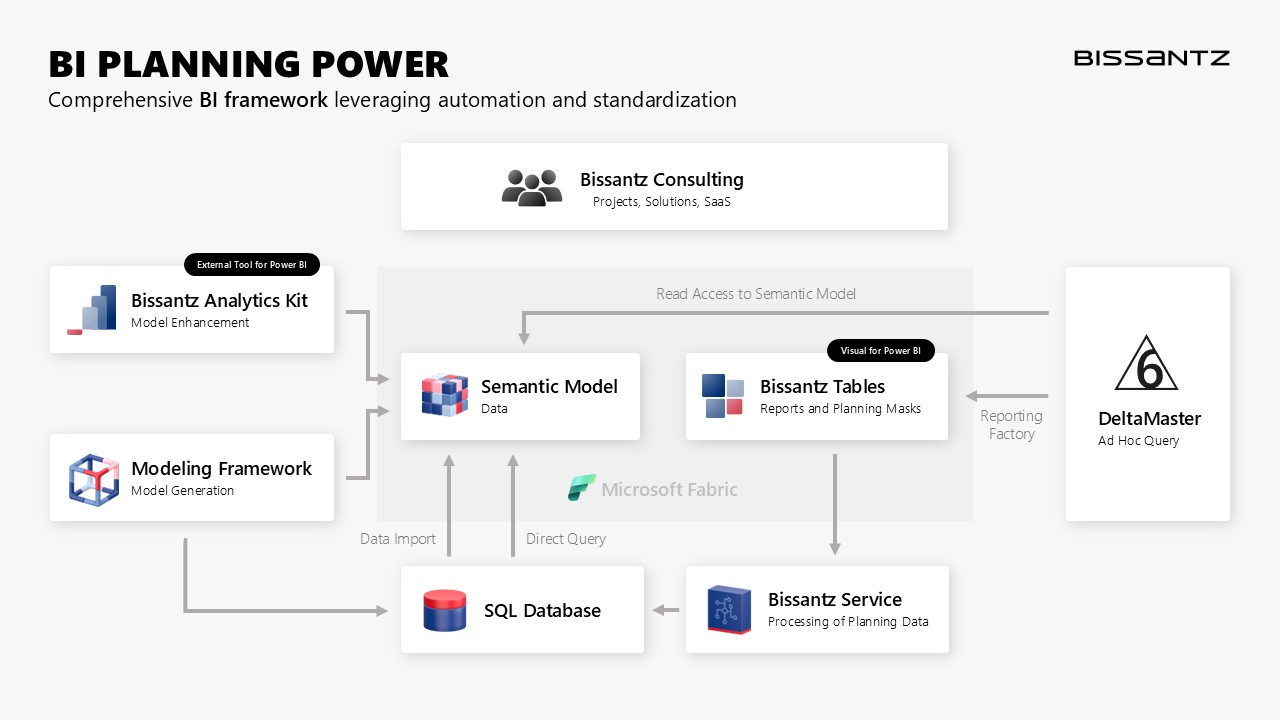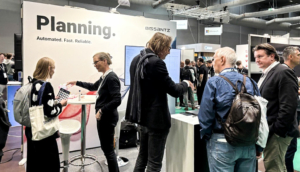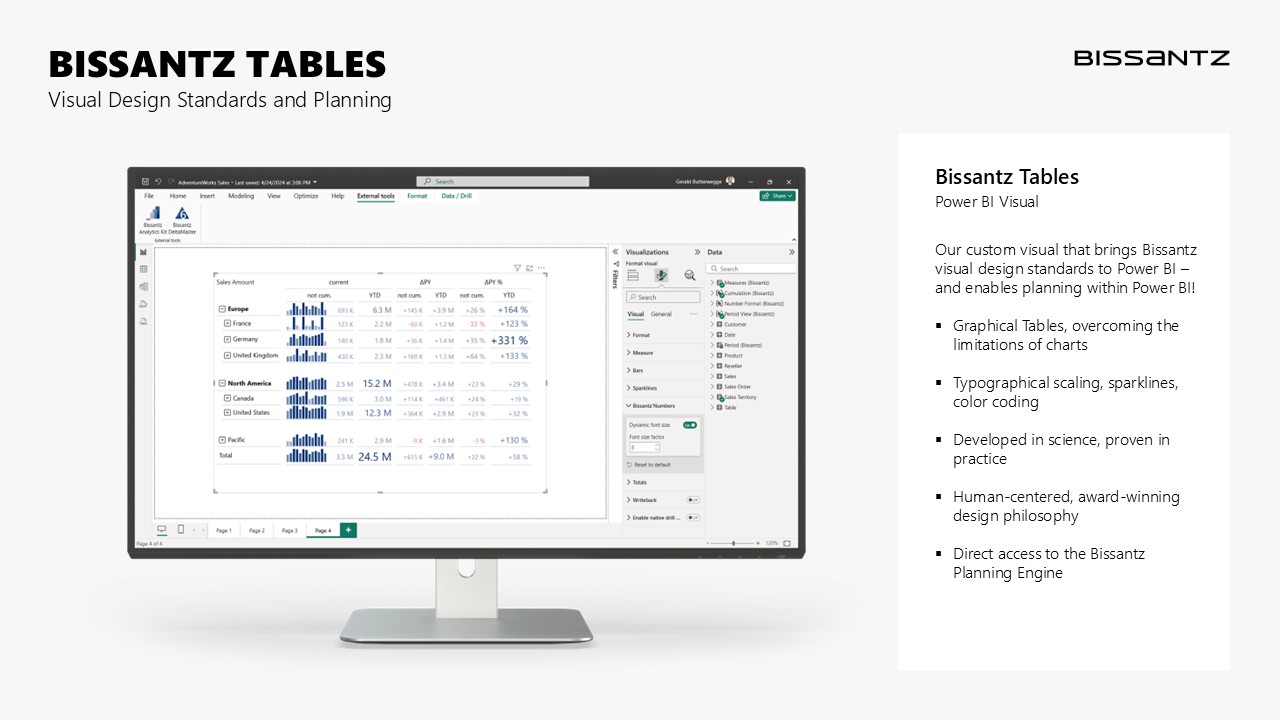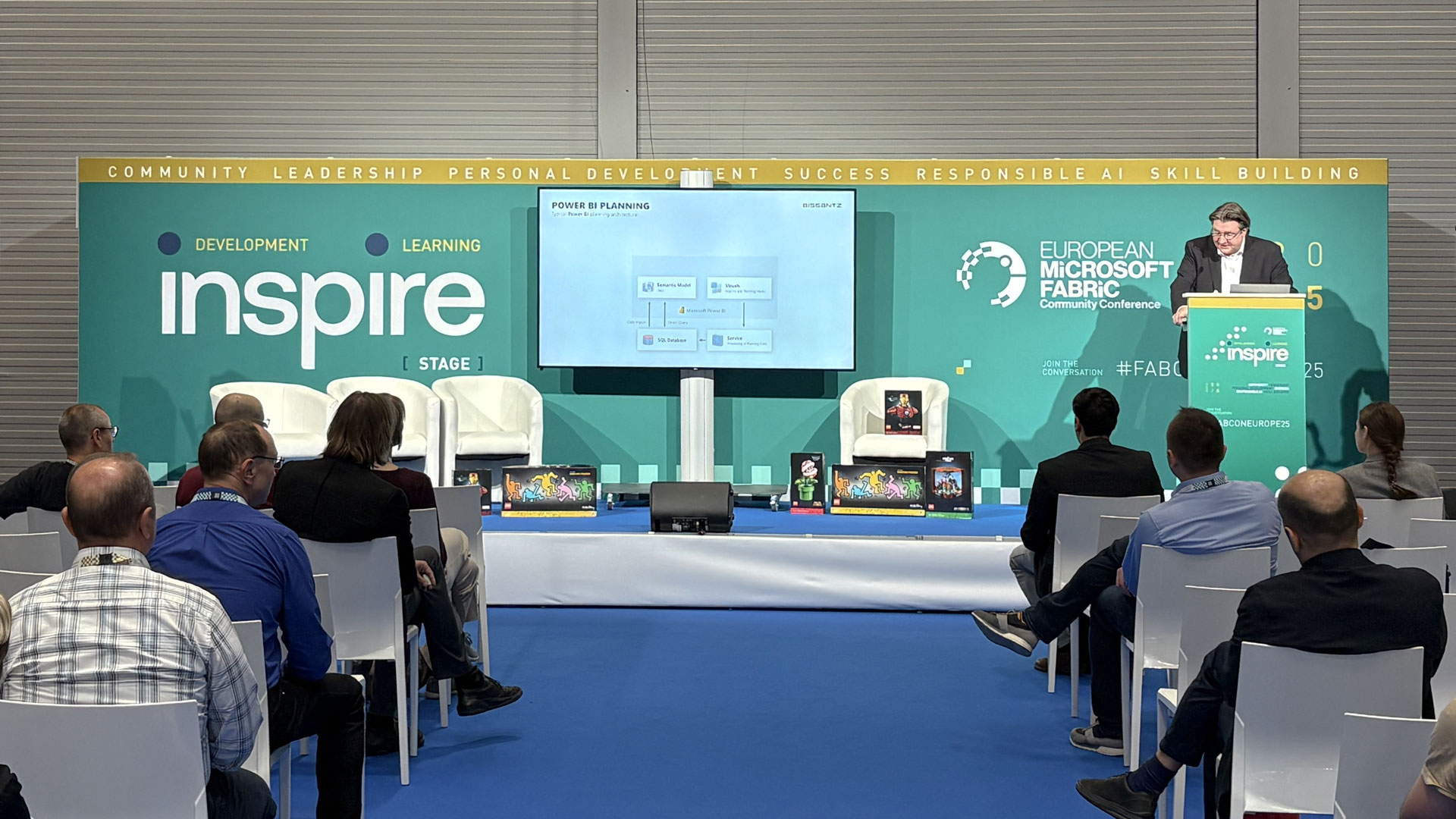From September 15 to 18, 2025, Vienna became the European hub for the global Microsoft Fabric community. For four days, FabCon Vienna 2025 was all about data platforms, analytics, AI, and Power BI – and one big question: What role will Fabric play in the corporate steering of tomorrow?
As a Gold Sponsor, we took the stage to showcase our approaches to planning, modeling, and visualization in Microsoft Fabric – and to gather firsthand feedback from the community.
Innovations in Focus
Expectations for Fabric are high. Microsoft positions the platform as the new standard for data integration, analytics, AI, and business intelligence. But in day-to-day controlling and decision-making, one thing quickly becomes clear: planning, governance, and reliable visualization require more.
That’s where Bissantz makes the difference. In Vienna, we introduced a complete package of innovations designed to bridge Fabric with practical, real-world performance management:
- Bissantz Modeling Framework – standardizes and automates modeling, accelerating projects that otherwise demand heavy manual effort.
- Bissantz Planning Engine – extends Fabric with write-back, governance, and proven best practices for planning. Fabric becomes not only a platform for analytics, but also for robust corporate planning.
- Bissantz Tables – enable planning directly in Power BI, using a visual that also incorporates our award-winning design standards.
- Bissantz Analytics Kit – turns existing models into powerful controlling applications at the push of a button, enriched with business best practices.
- DeltaMaster and DeltaApp – our frontends run natively with Fabric: DeltaMaster for advanced planning and analysis, DeltaApp for mobile dashboards and fast insights.
Visitors repeatedly told us: the combination of Fabric + Power BI + Planning Engine + Bissantz Tables closes a long-standing gap in practice.
Live Demo on the Inspire Stage
One highlight was our session on September 17 at 4:45 p.m. on the Inspire Stage. Dr. Gerald Butterwegge, Head of Communications, demonstrated live how a Fabric model can be transformed into a production-ready planning application in minutes.
“Planning in Power BI – with the same standards that Bissantz has set for years – was a real eye-opener for many,” said Butterwegge. “Governance features like locking, permissions, and monitoring were visible right away, out of the box. And the seamless switch between analysis, planning, and reporting clearly impressed.”
Rather than relying on Power BI’s typical, limited planning approaches, we harness the full power of BI for planning. By linking Power BI with our Modeling Framework, we provide all the essential planning functions in the backend.
At the core lies the Planning Engine, delivering indispensable features like write-back, transactions, locking, splashing, permission management, and monitoring. These components turn Fabric into a platform that doesn’t just analyze, but also enables planning of a new quality.
 Typical Planning Architecture in Microsoft Fabric with Integration of the Bissantz Planning Engine
Typical Planning Architecture in Microsoft Fabric with Integration of the Bissantz Planning Engine
Strong Response at Our Booth
Our booth, right next to the Inspire Stage, was buzzing with activity throughout the event and quickly became a hub for expert discussions. Our six-person team – Michael Westphal (Consulting & Management), Dr. Gerald Butterwegge (Communications), Torsten Krebs (Consulting), Aleksandra Pushkina (Consulting), Heike John (Sales), and Murat Suner (Storytelling) – engaged the FabCon community from multiple angles: technical modeling, visual standards, market perspectives, and customer needs.
Many visitors stopped by right after our talks to dive deeper into the live demo. Others used the chance to ask about concrete projects and use cases. Topics in especially high demand included combining Fabric with planning, Power BI integration, and our Analytics Kit.
 What became clear in these conversations: companies are already investing heavily in Fabric but still seek guidance on how to build productive controlling and planning solutions. Our approach resonated strongly with that need.
What became clear in these conversations: companies are already investing heavily in Fabric but still seek guidance on how to build productive controlling and planning solutions. Our approach resonated strongly with that need.
Visualization: Clarity Over Show
Many sessions dazzled with colorful dashboards and 3D effects. “The community celebrates 3D charts that look spectacular, but they don’t actually reveal what’s happening in the data,” observed consultant Aleksandra Pushkina.
This is where Bissantz stands apart: our visualization follows the principles of human perception. “You don’t need to be a super-controller to immediately spot the biggest variance in DeltaMaster,” added Dr. Butterwegge.
 Bissantz Tables in Power BI for Planning and Visualization
Bissantz Tables in Power BI for Planning and Visualization
Fabric Impresses – With Limits
“With Fabric, Microsoft really has brought everything together in one integrated whole. The breadth is impressive – from data integration and AI to real-time processes. At the same time, Fabric is still a construction kit: it offers many components, but not yet complete solutions,” noted Michael Westphal, Head of Consulting and Managing Director.
Planning: The Missing Piece
One key learning: planning is absent in Power BI. “Many use Power BI, but they don’t plan with it – simply because it’s not possible,” emphasized consultant Aleksandra Pushkina.
That’s why the response to our solutions was so strong. “With Bissantz Tables connected to our Planning Engine, we proved that planning in Power BI works – and works with the same standards our customers have relied on for years,” explained Torsten Krebs, Senior Manager.
Real-Time and Translytical Task Flows
The real-time analytics examples impressed many attendees. “More and more decisions will be made in real time, not after monthly reports,” summarized Westphal.
But realism is important: not every industry needs real time. “For many, daily or even monthly updates are sufficient – corporate culture often dictates how steering actually works,” he added.
Data Security: Trust Remains Key
Amid the excitement, one topic kept surfacing: data security. “Our customers are cautious – where are the servers located, who can access the data?” reported Sales Manager Heike John. Microsoft responds with tenant isolation and clear commitments, but trust remains a sensitive issue.
Our Takeaways from Vienna
FabCon Vienna 2025 made one thing clear: Microsoft Fabric is becoming the standard for data integration and analytics. But only with extensions such as our Modeling Framework, Planning Engine, Bissantz Tables, and Analytics Kit does it become an environment that meets the high demands of controllers and planners.
For us, the conference was an invaluable opportunity to showcase our innovations – and to take home the questions and expectations of the community.
We return to Nuremberg with three key insights:
- Fabric is established – now it’s about delivering value beyond analytics.
- Planning must be integrated – not handled separately in Excel, but embedded in the same model.
- Design remains decisive – only when data is made truly understandable will it gain acceptance.
Or, as Michael Westphal put it: “Fabric offers a lot – but you still need someone to put the building blocks together in the right way.”


